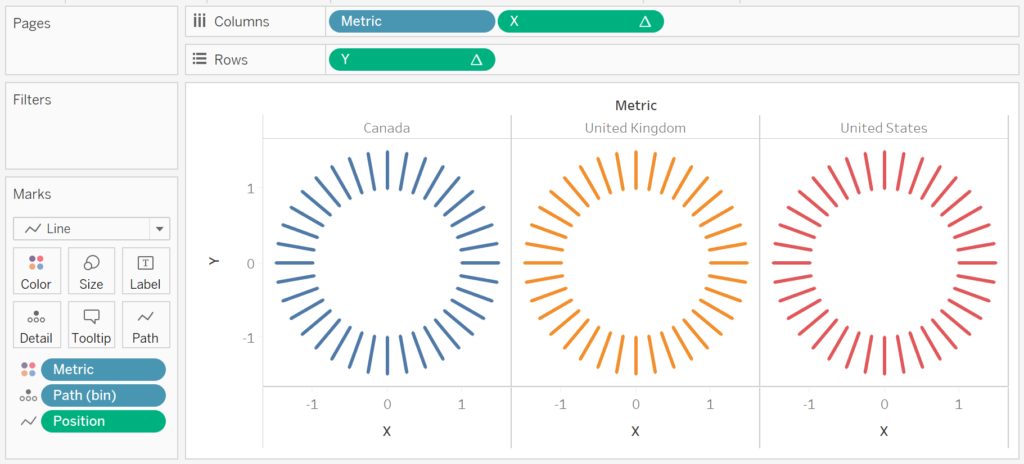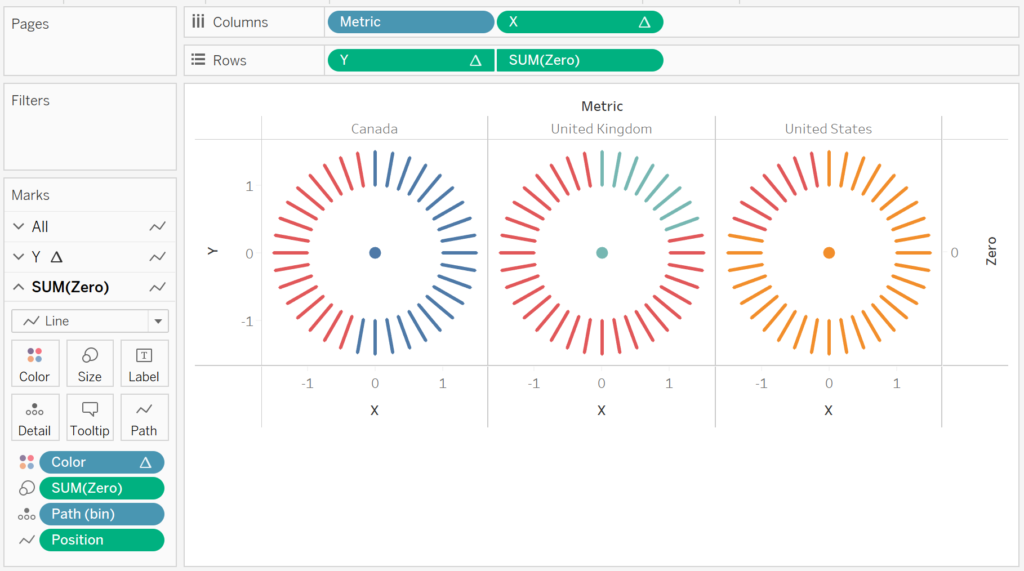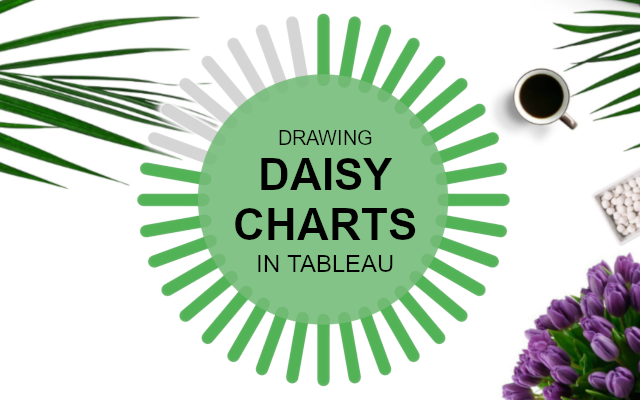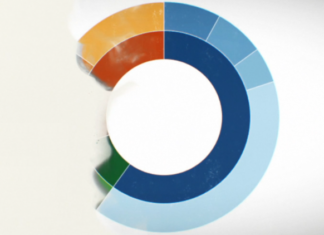On my way home from the London Tableau User Group (TUG) I was looking at Twitter and got inspiration from Kevin Flerlage (@FlerlageKev) and Rajeev Pandey (@rajvivan), so I thought I would design and write up my own version of this visualisation, please welcome the Daisy Chart.
Note: This is an alternative type of data visualisation, and sometimes pushed for by clients. Please always look at best practices for data visualisations before deploying into production.
Data
Load the following data into Tableau Desktop / Public.
| Metric | Path | Value | Position |
| United States | 1 | 0.8 | 1 |
| United States | 360 | 0.8 | 1 |
| United States | 1 | 0.8 | 1.5 |
| United States | 360 | 0.8 | 1.5 |
| United Kingdom | 1 | 0.2 | 1 |
| United Kingdom | 360 | 0.2 | 1 |
| United Kingdom | 1 | 0.2 | 1.5 |
| United Kingdom | 360 | 0.2 | 1.5 |
| Canada | 1 | 0.55 | 1 |
| Canada | 360 | 0.55 | 1 |
| Canada | 1 | 0.55 | 1.5 |
| Canada | 360 | 0.55 | 1.5 |
Note: we need four records for each Country as we are going to be drawing lines and using densification to get more points on our view. For more information, check out our article on Data Densification.
Calculated Fields
With our data set loaded into Tableau, we are going to create the following Calculated Fields and Bins:
Create Path (bin)
- Right click on Path, go to Create and select Bins…
- In the Edit Bins dialogue window:
- Set New field name to Path (bin).
- Set Size of bins to 10.
- Click Ok.
Index
INDEX()-1TC_Value
WINDOW_MAX(MAX([Value]))TC_Position
WINDOW_MAX(MAX([Position]))X
SIN(RADIANS([Index]*(360/WINDOW_MAX([Index]))))*[TC_Position]Y
COS(RADIANS([Index]*(360/WINDOW_MAX([Index]))))*[TC_Position]Zero
0Color
IF [Index] < (WINDOW_MAX([Index])*[TC_Value]) THEN
IF [TC_Value] >= 0.8 THEN
"Green"
ELSEIF [TC_Value] <= 0.2 THEN
"Red"
ELSE
"Amber"
END
ELSE
"Grey"
ENDNote: We are hardcoding the colors thresholds.
So now that we have created a lot of Calculated fields, we will now put this together into a Worksheet.
Worksheet
We will now build our worksheet:
- Change the Mark Type to Line.
- Drag Metric onto the Color Mark.
- Drag Metric onto the Columns Mark.
- Drag Path (bin) onto Columns.
- Right-click onto this object and ensure that Show Missing Values is checked.
- Drag this object onto the Detail Mark.
- Drag Position onto the Path Mark.
- Right-click on this object and select Dimension.
- Drag X onto Columns.
- Right-click on the object, go to
Compute Using and select Path (bin).
- Right-click on the object, go to
- Drag Y onto Rows.
- Right-click on the object, go to
Compute Using and select Path (bin).
- Right-click on the object, go to
If all goes well, you should have the following:

We will now make a few adjustments.
- Drag Color onto the Color Mark.
- Right-click on the object, go to
Compute Using and select Path (bin).
- Right-click on the object, go to
- Drag Zero onto Rows.
- Right-click on the object and select Dual Axis.
- In the Y Mark Panel.
- Remove Measure Names from the Color Mark.
- In the SUM(Zero) Mark Panel.
- Change the Mark Type to Circle.
- Remove Measure Names from the Color Mark.
- Drag Zero onto the Size Mark.
You should now see the following:

Now we will adjust the cosmetics:
- Set the Grid Lines to None.
- Set the Row Divider to None.
- Set the Column Divider to None.
- Hide the X-Axis.
- Hide the Y-Axis.
- Edit the Colors.
- Increase the Size of the Circle.
- Add a Label to the Circle.
- Add Transparency to the Circle.
If all goes well, you want to end up with the following:

and boom we are done… we have successfully created this fun data visualisation. You can find my data visualisation on Tableau Public at https://public.tableau.com/profile/toan.hoang#!/vizhome/DaisyCharts/DaisyChart
Extra Credit: Try changing the value Path (bin) and see the results, and adjust the size of the Line Mark.
Summary
I hope you all enjoyed this article as much as I enjoyed writing it and as always do share the love. Do let me know if you experienced any issues recreating this Visualisation, and as always, please leave a comment below or reach out to me on Twitter @Tableau_Magic.
If you like our work, do consider supporting us on Patreon, and for supporting us, we will give you early access to tutorials, exclusive videos, as well as access to current and future courses on Udemy:
- Patreon: https://www.patreon.com/tableaumagic
Also, do be sure to check out our various courses:
- Creating Bespoke Data Visualizations (Udemy)
- Introduction to Tableau (Online Instructor-Led)
- Advanced Calculations (Online Instructor-Led)
- Creating Bespoke Data Visualizations (Online Instructor-Led)























Nice work. Thank you for sharing.
Your welcome 🙂
Dear Toan!
Thank you for the great inspiration and invaluable insights you share with us, Tableau enthusiasts and lovers!
I try to learn as much as I can from the stuff, but in some cases I just get lost while trying improve the versions you’ve already built. As there was no option of giving feedback and ask questions under the topic I’m interested in, I write it down here. Namely, could you please help me with the Pointed Radial Chart. I got it working fine (though there were some things I had to figure out first), but I’d like to add an option of choosing target group for the chart – ie option that the radials would be drawn for the whole population and for those who plan to buy a new car, for example. I figured out that it has to do with calculation of Index measure, but I can’t quite find the right formula, so I’m hoping you might point me to the right direction with that.
Thank you already in advance!
Hi Külli,
Yes, it will require a little more manipulation if you want to make this dynamic and to work on your data with filters. Without knowing your data, you will have to look at the WINDOW_MAX calculations, and also to turn them in Context Filters. If you can, email me at admin@tableau.toanhoang.com and I will try to have a look.
Kind Regards,
Toan
This was terriffic. I liked this however i wanted to i am having my own data how can i perform the operations on my data please let me know. That would be really helpful.
Hi Vikrant, you will need to perform some additional aggregations using Table Calculations.
How to do that. Can u explain that as that would be great.
How to do that. Can u explain that as that would be great. i have sent the file on following email-id admin@tableau.toanhoang.com . Please help
Sure, I will have a look over the weekend.
Thank you Toan will wait for your response. I think the concept is more important – because if i understand the concept than i can visualise any kind of data and plot daisy chart. Will be waiting for your response. Thanks again in advance
how do I add a Label to the Circle – sorry – probably easy – thank
Stephen
Hi Stephen, you just need to drag the value onto the Label and align to center. Kind Regards, Toan
when I drag the value to the Sum(Zero) Mark it places the value multiple times
?
If you go to the SUM(Zero) Mark Panel and remove the details, you will see that this should go. If it still does not work, please send me an email to toan.hoang@tableau.toanhoang.com and I will forward you my workbook.
Hello, here two calculations need edit TC_Value and TC_Position. Both should be divided by 4 as shown in Youtube video.
I tried with all the calculations above but result was not coming correct and after seeing the video realised both should be divided by 4